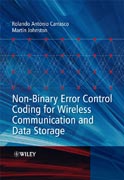
Non-binary error control coding for wireless communication and data storage
Carrasco, Rolando Antonio
Providing an introduction to the different non-binary error-correction codingtechniques and their application to wireless communication and data storage scenarios, Non-Binary Error Control Coding for Wireless Communication and Data Storage covers all essential material available on this pertinent area of research. The design and construction of good non-binary codes are explained with descriptions of efficient non-binary decoding algorithms with applications forwireless communication and high-density data storage. Detailed worked examples for each coding scheme supplement concepts for researchers and post-graduatestudents immersing themselves in the field. INDICE: Acknowledgements Preface Chapter 1 - Information, Channel Capacityand Channel Modelling Introduction 1.2. Measure of Information 1.3. Channel Capacity 1.4 Channel Modelling 1.5. Definition of a communications channel and its parameters 1.6. Multiple Input Multiple Output (MIMO) Channel 1.8. Magnetic Storage Channel Modelling 1.9. Summary References Chapter 2 - Basic Principles of Non-Binary Codes 2.1. Introduction to Algebraic Concepts 2.2. Algebraic Geometry 2.3. Conclusions Chapter 3 - Non-Binary Block Codes 3.1. Introduction3.2. Fundamentals of Block Codes 3.3. Bose-Chaudhuri-Hocquenghem (BCH) Codes Example 3.3. Constructing a non-binary BCH code over GF(4) of length n = 15 symbols 3.4. Reed-Solomon Codes Example 3.4: Constructing a non-binary BCH code over GF(16) of length n = 15 symbols 3.5. Decoding Reed-Solomon Codes 3.6. Coded Modulation 3.7. Conclusions References Chapter 4 - Algebraic-Geometric Codes 4.1. Introduction 4.2. Construction of Algebraic-Geometric Codes 4.3. Decoding Algebraic-Geometric Codes 4.4. Majority Voting 4.5. Calculating the Error Magnitudes. 4.6. Complete Hard-Decision Decoding Algorithm for Hermitian Codes.4.8. Simulation Results 4.9. Conclusions References Chapter 5 - List Decoding5.1. Introduction 5.2. List Decoding of Reed-Solomon Codes using the Guruswami-Sudan algorithm 5.3. Soft-Decision List Decoding of Reed-Solomon codes usingthe Kötter-Vardy Algorithm. 5.4. List Decoding of Algebraic-Geometric Codes 5.5. Determining the Corresponding Coefficients 5.6. Complexity reduction Interpolation 5.7. General Factorisation 5.8. Soft-Decision List Decoding of Hermitian Codes 5.9. Conclusions References Chapter 6 - Non-Binary Low Density Parity Check Codes 6.1. Introduction 6.2. Construction of Binary LDPC Codes Random and Structured Methods 6.3. Decoding of Binary LDPC Codes using the Belief Propagation Algorithm. 6.4. Construction of Non-Binary LDPC Codes defined over Finite Fields 6.5. Decoding Non-Binary LDPC Codes with the Sum Product Algorithm6.6.Conclusions References Chapter 7 - Non-Binary Convolutional Codes References Chapter 8 - Non-binary Turbo codes 8.1. Introduction 8.2. The turbo encoder 8.3. The Turbo Decoder 8.4. Non-Binary Turbo Codes 8.5. Conclusion References
- ISBN: 978-0-470-51819-9
- Editorial: John Wiley & Sons
- Encuadernacion: Cartoné
- Páginas: 328
- Fecha Publicación: 19/12/2008
- Nº Volúmenes: 1
- Idioma: Inglés
